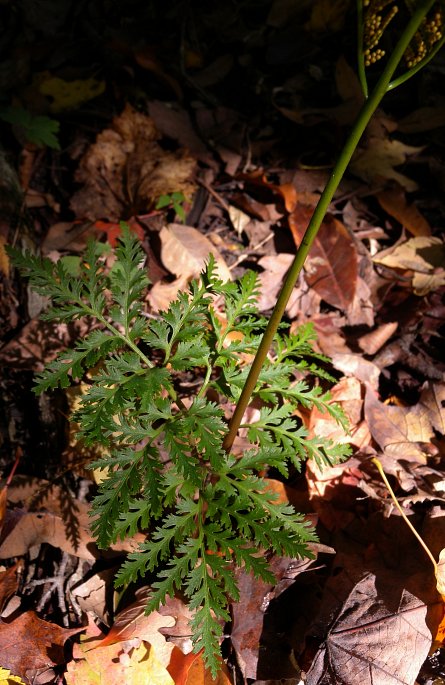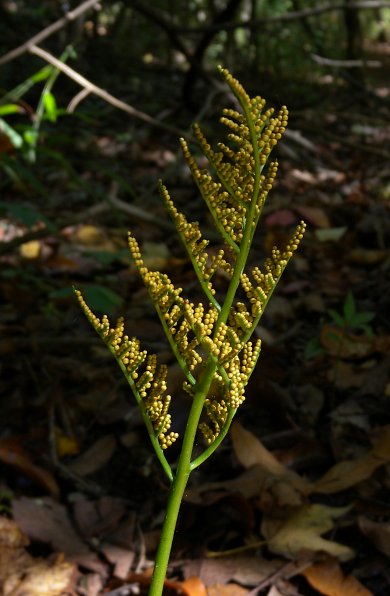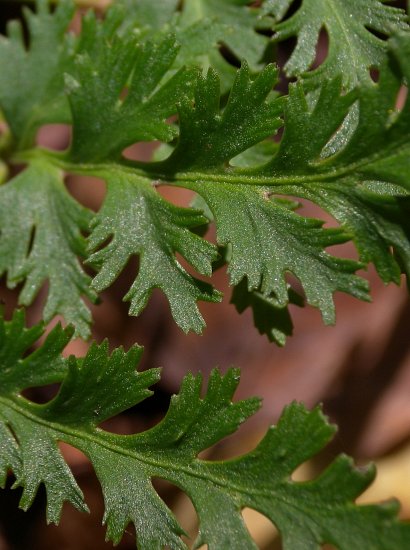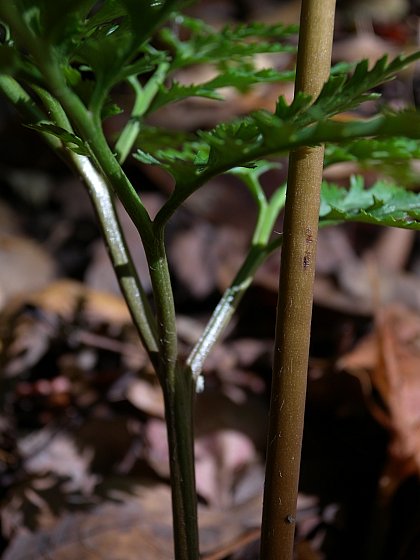
The petiole of the fertile leaf originates from the same stalk as the petiole of the sterile leaf, but they diverge from each other near the ground surface. This latter petiole is up to 12" long, somewhat succulent, light green to brown, glabrous, and fully terete. The compound fertile leaf is up to 6" long and 4" across, ultimately becoming erect; it is medium green and glabrous. The compound fertile leaf is severely constricted; it has a branching stalk-like appearance, resembling a panicle of sporangia. The globoid sporangia (about 1 mm. across at maturity) are located along the terminal branches of the fertile leaf. The sporangia are pale yellow and glabrous. At maturity, each sporangium splits open to release its pale yellow to white spores to the wind. This typically occurs during late fall or early winter. At this time, the fertile leaf turns brown and dries up, persisting in this state through the winter and into the following year. After exposure to hard frost and cold winter temperatures, the evergreen sterile leaf of this fern assumes a brownish bronze coloration that persists until it withers away during the following spring. The root system is fleshy and fibrous.

Cultivation: The preference is partial sun to medium shade, moist to dry-mesic conditions, and soil containing loam or sandy loam with decaying organic material. This fern is slow to develop from its spores, as the subterranean body of the fern (or prothallus) that results from its sexual phase lacks chlorophyll. At this stage of development (lasting 5 or more years), it is totally dependent on mycorrhizal fungi for survival. Even when the emergent sterile and fertile leaves of this fern develop, it is still partially dependent on such fungi for many of its nutrients. It has been estimated that the Cutleaf Grapefern can live for about 10 to 45 years (Chadde & Kudray, 2001). Because there is no easy way to cultivate this fern, it is rarely, if ever, available from commercial markets.

Range & Habitat: The native Cutleaf Grapefern is scattered across Illinois, where it is uncommon (see Distribution Map). Habitats include sandy grasslands, open disturbed woodlands, upland woodlands, bottomland woodlands, wooded ravines, wooded slopes of bluffs, shaded roadsides, areas along woodland paths, edges of swamps, and pastures. This evergreen fern favors woodlands with deciduous trees as it is able to conduct photosynthesis during the warmer days of fall, winter, and spring after the tree leaves have fallen. Upland woodlands are typically dominated by oaks and hickories, while lowland woodlands are typically dominated by maples and basswood. The Cutleaf Grapefern (Botrychium dissectum dissectum) often occurs with the more common Bronze Fern (Botrychium dissectum obliquum). Fidelity to any particular habitat is low.

Faunal Associations: Very little is known about floral-faunal relationships for this fern. The Wild Turkey and probably the Ruffed Grouse feed on the leaves, as does the White-Tailed Deer. Predation of the leaves is mostly likely to occur during the spring and fall, when the Cutleaf Grapefern is more conspicuous. The impact of such browsing on the survival of this fern is less than what might be expected because it derives many of its nutrients from underground fungi (Chadde & Kudray, 2001).
Photographic Location: Along a woodland path at Walnut Point State Park in Douglas County, Illinois.

Comments: The finely dissected sterile leaves of this small attractive fern are distinctive. It is possible to confuse Cutleaf Grape Fern (Botrychium dissectum dissectum) with the Rattlesnake Fern (Botrychium virginianum), although plants of this latter fern have sterile leaves that are deciduous, rather than evergreen. In addition, each sterile leaf of this latter fern is sessile against the central stalk that it shares with the developing fertile leaf (during those years when the latter occurs). In spite of the fact that they are considered different varieties of the same species, the Cutleaf Grape Fern looks very different from the more common Bronze Fern (Botrychium dissectum obliquum). The sterile leaves of the latter fern are less dissected and the terminal leaflets of its subdivisions are often relatively large and trowel-shaped.